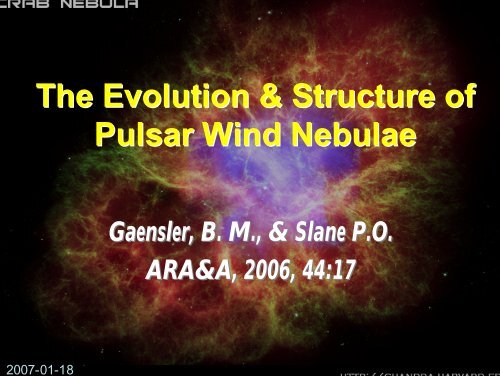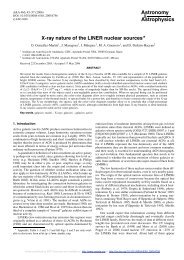The Evolution & Structure of Pulsar Wind Nebulae
The Evolution & Structure of Pulsar Wind Nebulae
The Evolution & Structure of Pulsar Wind Nebulae
You also want an ePaper? Increase the reach of your titles
YUMPU automatically turns print PDFs into web optimized ePapers that Google loves.
<strong>The</strong> <strong>Evolution</strong> & <strong>Structure</strong> <strong>of</strong><br />
2007-01-18<br />
<strong>Pulsar</strong> <strong>Wind</strong> <strong>Nebulae</strong><br />
Gaensler, B. M., & Slane P.O.<br />
ARA&A, 2006, 44:17
References<br />
•Observational Observational : Gaensler, B. M., &<br />
Slane P.O. ARA&A, 2006, 44:17<br />
•<strong>The</strong>oretical <strong>The</strong>oretical : Reynolds & Chevalier,<br />
1984, ApJ, 278:630 (RC84)<br />
•Swaluw, et al., 2004, A&A, 420:937;<br />
Chevalier, 2005, ApJ, 619:839
• SNR => pulsar-driven SNR => PWN<br />
• Prototype: Crab
<strong>The</strong> Prototype— Prototype Crab nebula<br />
• SN 1054<br />
• Central star 16m pulsar<br />
• P=33 ms<br />
• Pdot=36 ns/day<br />
• Edot~5*10^38 erg/s<br />
• L~3*10^38 erg/s<br />
• <strong>Pulsar</strong>-driven wind nebula
<strong>The</strong>oretically <strong>The</strong>oreticall<br />
• Marvelous testing ground for studying<br />
– Relativistic flows and their<br />
interactions with surrounding<br />
– Shocks<br />
– <strong>Pulsar</strong> itself<br />
– Mechanisms <strong>of</strong> high v birth kicks <strong>of</strong><br />
pulsars<br />
– etc.
<strong>The</strong>ory <strong>of</strong> pulsar & radiation<br />
• Spin-down<br />
– Edot<br />
– n<br />
– Age<br />
– B<br />
• <strong>Evolution</strong><br />
– P(t)<br />
– Edot(t)<br />
• Crab<br />
(Manchester & Taylor 1973)<br />
(Pacini & Salvati 1973)
<strong>Pulsar</strong> <strong>Wind</strong>-magnetodynamic<br />
<strong>Wind</strong> magnetodynamic<br />
• Goldreich & Julian 1969<br />
• Kennel & Coroniti 1984a,b<br />
• Bogovalov & Khangoulyan 2002<br />
• Bogovalov et al. 2005
Emission & Spectra <strong>of</strong> nebulae<br />
• Synchrotron<br />
S<br />
ν<br />
ν −<br />
∝<br />
(Ginzburg & Syrovatskii, et al., 1965)<br />
α<br />
• Radio:<br />
• X-ray:
Emission & Spectra <strong>of</strong> nebulae<br />
• <strong>The</strong> nature <strong>of</strong> this spectral steepening is not<br />
understood; theory above is based on a simple<br />
pow-law assumption.<br />
• Rapid decline <strong>of</strong> injection (inherent<br />
spectrum deviate from power-law?),<br />
modifications from discrete acceleration<br />
sites, all contribute to a complicated<br />
integrated spectrum.<br />
• “As a result, the interpretation <strong>of</strong> spectral<br />
steepening as being due to synchrotron losses<br />
can lead to drastically wrong conclusions<br />
about PWN properties.”<br />
1
Observationally<br />
• Detailed structrues: Crab especially<br />
• 40-50 PWN<br />
• Category:<br />
– Composite (with a shell-like SNR)<br />
– Crab-like<br />
– Cometary (pulsar with high v, few)<br />
• <strong>Evolution</strong><br />
1
<strong>Evolution</strong><br />
• Phase I – Expanding into Unshocked<br />
Ejecta<br />
• Phase II – Interact with SNR Reverse<br />
Shock<br />
• Phase III – Inside a Sedov Shock<br />
• Phase IV – <strong>Pulsar</strong> in Interstellar Gas<br />
1
Phase I – Expanding into<br />
Unshocked Ejecta<br />
1
Phase I<br />
1
•Chevalier, 1977<br />
•RC84<br />
1
Torus, Jet, Wisp & Filament<br />
2
Jet<br />
• <strong>The</strong>ory: Invisible in standard model<br />
• Observation: visible!<br />
• kink instabilities in the toroidal field<br />
accelerate particles<br />
• limit collimation curved jets<br />
• a wide variation in fraction <strong>of</strong> Edot<br />
considerable differences in the<br />
additional acceleration efficiency<br />
2
• G54.1+0.3: luminosity, geometry<br />
(Lu et al., 2002)<br />
Puzzles<br />
2
G320.4-1.2<br />
2
Wisp<br />
ACIS-S3<br />
(11/3/2000-<br />
4/6/2001)<br />
v ~ 0.5c<br />
(Heter et al.<br />
2002)<br />
(Koji Mori,<br />
2002)<br />
2
Wisp<br />
• Variation nature: unveiled<br />
– Synchrotron instabilities<br />
– Cmpression <strong>of</strong> e/e + pair plasma (~0.15 pc)<br />
• Radio structures (VLA) similar to<br />
optical/X-ray accelerate in the same<br />
region as for the X-ray emitting<br />
population (Bietenholz et al. 2004)<br />
2
• Optical:<br />
Filaments<br />
– R-T instabilities as the<br />
expanding relativistic<br />
bubble sweeps up and<br />
accelerates slower<br />
moving ejecta (Hester<br />
et al. 1996)<br />
– simulation 60-75%<br />
mass concerntration<br />
(eg.,Jun 1998)<br />
2
• Radio:<br />
Filaments<br />
– Expanding PWN<br />
encounters filaments,<br />
compress & increase n &<br />
B enhance<br />
synchrotron emission<br />
(Jun 1998, Bucciantini et<br />
al. 2004)<br />
• No X-ray:<br />
– High energy electron<br />
suffer synchrotron<br />
loss<br />
3
Filaments<br />
• X-ray filaments <strong>of</strong> 3C58: associated with radio,<br />
not with optical<br />
different mechanism<br />
-magnetic loops torn<br />
from the toroial field<br />
by kink instabilities<br />
3
Phase II – Interact with<br />
SNR Reverse Shock<br />
3
Phase II<br />
Phase III<br />
3
Phase III – Inside a Sedov<br />
Shock<br />
3
Phase II<br />
Phase III<br />
3
Phase IV – <strong>Pulsar</strong> in<br />
Interstellar Gas<br />
3
Phase III<br />
Phase IV<br />
3
Bow shock & Cometary PWN<br />
• V PSR ~ 400-500 km/s, 1000 km/s<br />
3
Other & Recent results<br />
• Very young pulsar & PWN<br />
– Crab, 3C58(1181?), SN1987A, SN1986J<br />
• <strong>Wind</strong>s from highly magnetized NS<br />
• TeV Observations <strong>of</strong> PWN<br />
– Crab (Weekes et al. 1989, etc.)<br />
• <strong>Pulsar</strong> <strong>Wind</strong>s in Binary Systems<br />
– Double pulsar PSR J0737-3039<br />
– PSR B1957+20, PSR B1259-63<br />
3
Thank you for your attention!<br />
4
















